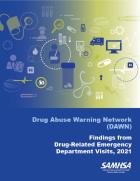The N-SUMHSS is a voluntary annual survey of all active substance use and mental health facilities in the United States, its territories, and D.C. The annual report presents findings on the key operational characteristics of substance use and mental health treatment facilities, use of pharmacotherapies, language assistance services, and suicide prevention assistance services.
Dashboard: Filter Bricks
Main page content


This document updates SAMHSA’s 2018 document and outlines best practices for the implementation and operation of recovery housing. These best practices are intended to serve as a tool for states, governing bodies, providers, recovery house operators, and other interested stakeholders to improve the health of their citizens, reduce incidence of overdose, and promote recovery housing as a key support strategy in achieving and sustaining recovery.

An analysis of the 2022 DAWN data presents nationally representative weighted estimates of all drug-related emergency department (ED) visits, nationally representative weighted estimates of the top substances involved in drug-related ED visits, including rates by race and ethnicity; nationally representative weighted estimates of opioid- related ED visits by type of opioid, drugs involved in polysubstance ED visits, and the identification of newly mentioned drugs in 2022.

This practical guide updates and expands the discussion presented in SAMHSA's Concept of Trauma and Guidance for a Trauma-Informed Approach Resource from 2014. The primary goal of this guide is to provide implementation strategies across multiple domains based on the original publication.

Read key findings from the 2021 National Survey on Drug Use and Health (NSDUH) on substance use, mental health, and treatment. Metrics in the report cover the civilian, noninstitutionalized US population ages 12 and older. Estimates are presented by age group and by race/ethnicity for selected measures. Unlike other NSDUH Annual National Reports, the 2021 report has no discussion of trends over time, because changes in survey methodology mean the indicators are not comparable to past NSDUH estimates.

This advisory introduces readers to Cannabidiol (CBD), how it is derived, how it differs from THC and other cannabinoids, the risks and harms of CBD use, and common misconceptions given its broad availability.

The N‑SUMHSS is a voluntary annual survey of all active substance use and mental health facilities in the United States, its territories, and D.C. The annual report presents findings on the general profile of substance use and mental health facilities, use of pharmacotherapies/medications, language assistance provided, and suicide prevention services.

This guide highlights strategies for behavioral health and housing providers to conduct outreach and engage with individuals experiencing homelessness, initiate use of behavioral health treatment as they wait to receive stable housing and retain them in their recovery efforts once housed.

An analysis of final 2021 DAWN data presents: (1) nationally representative weighted estimates, including percent and unadjusted rates per 100,000, for all drug-related emergency department (ED) visits, (2) nationally representative weighted estimates for the top five drugs in drug-related ED visits, (3) the assessment of monthly trends and drugs involved in polysubstance ED visits in a subset of sentinel hospitals, and (4) the identification of drugs new to DAWN’s Drug Reference Vocabulary.

A series of 10 technical assistance collaborative papers providing important resources for state leaders, policy makers, providers, peers and others to learn from examples around the country and hear from thought leaders about innovative services and the need for further 988 implementation. Produced by SAMHSA in conjunction with the National Association of State Mental Health Program Directors.
Displaying 1 - 10 out of 105

